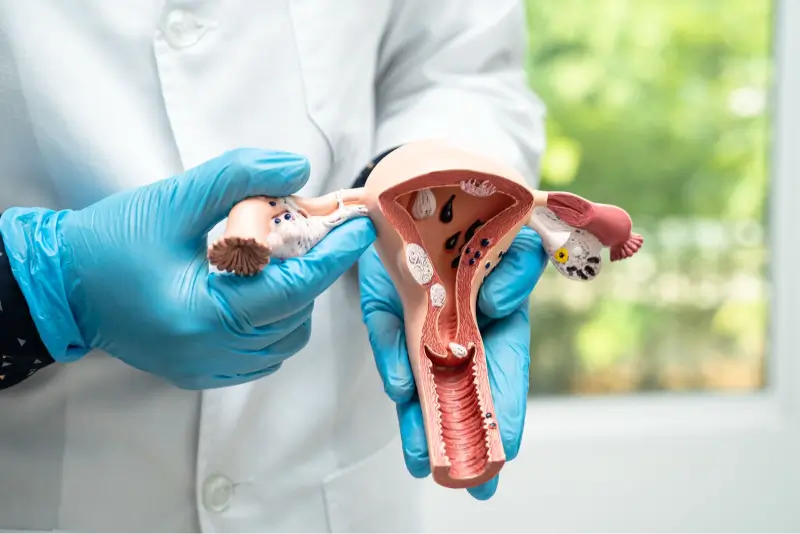
How Do I Know If I Have Vaginismus: The Questions You’re Afraid to Ask!
How Do I Know If I Have Vaginismus?
Ever felt like your body is working against you when it comes to intimacy? If you’re wondering, “How do I know if I have vaginismus?” The answer lies in understanding how your body responds to penetration. Vaginismus is a condition where the muscles around the vagina tighten involuntarily, making penetration painful—or sometimes impossible. It’s not just about physical discomfort; it can also bring frustration, anxiety, and even fear of intimacy.
Vaginismus can be something you’ve always had (primary vaginismus) or something that develops later in life (secondary vaginismus), which is more common during menopause. The key to managing it is understanding why it happens and how menopause-related changes might be playing a role.
Signs that vaginismus may be affecting you:
- A burning or stinging sensation during intercourse
- Difficulty inserting tampons or undergoing gynecological exams
- Feeling anxious or fearful about penetration, even if you want to be intimate
How Do I Know If I Have Vaginismus During Menopause?
Menopause brings significant hormonal shifts, particularly a decline in estrogen, which can impact vaginal health and contribute to vaginismus. Here’s how:
- Vaginal Dryness & Thinning: Reduced estrogen leads to vaginal atrophy (thinning of vaginal walls), making penetration uncomfortable and triggering involuntary muscle tightening.
- Pelvic Floor Changes: Menopause can cause pelvic floor muscles to become either too tight or too weak, both of which can contribute to pain.
- Decreased Libido & Anxiety: Shifts in body image, self-esteem, and sexual desire during menopause can make intimacy stressful, reinforcing the cycle of pain and avoidance.
- Fear of Pain: If penetration becomes painful due to dryness or tightness, the fear of discomfort can lead to subconscious muscle contractions, worsening the condition
Why Does Vaginismus Happen During Menopause?
Vaginismus can develop or worsen during menopause due to a mix of physical and psychological factors. Hormonal shifts affect vaginal health, while emotional factors—such as anxiety, past experiences, and self-perception—can contribute to the condition. If you’ve been wondering, “How do I know if I have vaginismus?” Understanding these triggers can help you recognize and manage them effectively.
The Role of Hormonal Changes (Declining Estrogen)
Estrogen plays a key role in maintaining vaginal elasticity, lubrication, and overall tissue health. As menopause leads to declining estrogen levels, several changes occur:
- Thinning of vaginal walls (vaginal atrophy): The tissues become less flexible and more prone to discomfort.
- Reduced natural lubrication: Dryness increases friction, making penetration painful and triggering involuntary muscle contractions.
- Decreased blood flow to the vaginal area: Lower circulation can reduce sensitivity and make intercourse uncomfortable, reinforcing the cycle of pain and muscle tightening.
Vaginal Dryness and Loss of Elasticity
With less estrogen, vaginal tissues lose their ability to stretch and self-lubricate, leading to:
- A persistent feeling of tightness or burning during intercourse
- Small tears or micro-abrasions in the vaginal walls, making penetration painful
- Avoidance of intimacy due to fear of pain, which can cause emotional distress and relationship strain
Even routine activities—like using tampons or undergoing a gynecological exam—can become uncomfortable. Over time, this discomfort may lead to subconscious muscle tightening, reinforcing vaginismus.
What Are the Symptoms of Vaginismus?
Vaginismus affects more than just intimacy—it can lead to physical, psychological, and sexual health challenges. Women experiencing vaginismus often struggle with persistent discomfort, and conditions like bladder infections, UTIs, and yeast infections can further intensify the pain.
Several factors may contribute to vaginismus, including:
- Anxiety disorders: Chronic anxiety can make the body more prone to muscle tension, including the involuntary tightening of vaginal muscles.
- Childbirth injuries: Vaginal tears or trauma from childbirth can cause lingering pain and discomfort, making penetration difficult.
- Prior surgery: Surgical procedures affecting the pelvic area may lead to scarring or muscle tightness, increasing sensitivity and discomfort.
- Fear of sex or negative feelings about intimacy: Past experiences, including sexual abuse, rape, or trauma, can create subconscious muscle contractions as a protective response.
If you’re wondering, “How do I know if I have vaginismus?” and these symptoms resonate with you, it’s important to remember that vaginismus is treatable. Seeking medical guidance, pelvic floor therapy, and relaxation techniques can help break the cycle of pain and tension, restoring comfort in intimacy.
How Is Vaginismus Managed or Treated?
Vaginismus treatment focuses on relaxing the vaginal muscles while also addressing the psychological factors that contribute to the condition. Your healthcare provider may recommend one or more of the following approaches:
1. Topical Therapy
Applying topical lidocaine or compounded creams can help numb the vaginal area, reducing discomfort during penetration. These creams work by dulling pain signals, making it easier to engage in activities that might otherwise cause distress, such as using tampons or undergoing a gynecological exam.
2. Pelvic Floor Physical Therapy
Pelvic floor therapy involves working with a specialist who helps you identify and control your pelvic muscles. Many women with vaginismus unknowingly keep these muscles tense, and physical therapy teaches relaxation techniques to gradually ease the tightness. This can involve guided exercises, biofeedback, and breathing techniques to regain control over the pelvic floor.
3. Vaginal Dilator Therapy
Vaginal dilators are tube-shaped devices available in different sizes, designed to gradually stretch the vaginal muscles and desensitize the area to penetration. Your provider may recommend starting with a small-sized dilator, using a topical numbing cream if needed, and slowly increasing the size over time. This process helps reduce fear and muscle tension, making intimacy more comfortable.
4. Cognitive Behavioral Therapy (CBT)
CBT is a well-established method for addressing negative thought patterns that contribute to vaginismus. It helps women understand how their thoughts affect their emotions and behaviors. If fear, past trauma, or anxiety about penetration is a concern, CBT can help reframe those fears and build confidence in intimacy. It is particularly effective for individuals dealing with anxiety, depression, or PTSD related to past experiences.
5. Sex Therapy
A trained sex therapist can help individuals or couples navigate the emotional and psychological barriers that vaginismus creates in a relationship. These professionals provide guidance on rebuilding intimacy, exploring alternative forms of pleasure, and improving communication with a partner. If vaginismus has caused strain in your relationship, sex therapy can be a valuable part of the healing process.
By combining medical treatments, physical therapy, and psychological support, vaginismus can be successfully managed. The key is to break the cycle of fear, pain, and muscle tension, allowing the body to regain comfort and ease with penetration.
What Can I Do About Vaginismus During Menopause?
Vaginismus during menopause is not something you have to endure in silence—it is treatable. A combination of medical treatments, physical therapies, and emotional support can help relax the vaginal muscles, reduce pain, and restore confidence in intimacy. If you’ve ever wondered, “How do I know if I have vaginismus?”, recognizing the symptoms is the first step toward finding relief. Here’s what you can do:
1. Medical Treatments
Since menopause-related vaginismus is often linked to hormonal changes and vaginal dryness, medical treatments can help address the root cause:
- Hormone Therapy (Topical Estrogen) – Low-dose vaginal estrogen (available as creams, rings, or tablets) helps restore moisture, improve elasticity, and reduce discomfort.
- Lubricants & Vaginal Moisturizers – Water-based or silicone-based lubricants reduce friction during intercourse, while vaginal moisturizers provide long-lasting hydration.
- Vaginal Dilators – These small, tube-like devices help gradually stretch the vaginal muscles, allowing the body to adjust to penetration at a comfortable pace. They are often used under the guidance of a doctor or pelvic floor therapist
2. Pelvic Floor Therapy and Relaxation Techniques
Since vaginismus involves involuntary muscle contractions, learning to relax the pelvic floor is key to overcoming it.
- Pelvic Floor Physical Therapy – A specialist can guide you through exercises to release tension in the vaginal and pelvic muscles, improving comfort over time.
- Kegel Relaxation – While Kegel exercises are often recommended to strengthen pelvic muscles, focusing on releasing tension rather than contracting can be more beneficial for vaginismus.
- Breathing & Mindfulness Techniques – Deep breathing, meditation, and progressive muscle relaxation help ease anxiety and reduce muscle tightness.
- Gentle Stretching & Yoga – Certain yoga poses help relax the pelvic floor and improve blood flow to the vaginal area, reducing tension.
- Counseling and Emotional Support
Since vaginismus is often linked to emotional and psychological factors, addressing mental well-being is an essential part of treatment.
- Sex Therapy or Couples Counseling – A therapist specializing in sexual health can help navigate fears, anxieties, and relationship concerns.
- Cognitive Behavioral Therapy (CBT) – This technique helps reframe negative thoughts about intimacy and pain, breaking the cycle of fear and muscle tightening.
- Support Groups & Online Communities – Connecting with other women who have experienced vaginismus during menopause can provide reassurance, encouragement, and helpful coping strategies.
How to Talk About It With Your Partner
Talking about vaginismus can feel uncomfortable, but open communication is key to maintaining intimacy and understanding.
- Overcoming Embarrassment – Remember, vaginismus is a medical condition, not a personal failure. Choose a calm, private moment to talk and start with, “I want to share something important with you.”
- Encouraging Open Communication – Be honest about your experience—explain that it’s an involuntary muscle reaction, not a lack of desire. Reassure your partner that you still want closeness and involve them in your treatment journey.
- Finding Intimacy Beyond Penetration – Focus on non-penetrative intimacy like kissing, sensual touch, and cuddling. Explore relaxation techniques together and remove the pressure of performance.
Vaginismus during menopause can be challenging, but it is treatable with the right approach. Understanding its causes, recognizing the symptoms, and seeking medical or therapeutic support can help break the cycle of pain and discomfort. Open communication with your partner and exploring intimacy beyond penetration can also strengthen your relationship.
Most importantly, you are not alone—many women experience this, and help is available. With patience, self-care, and the right guidance, you can regain confidence and comfort in your intimate life.
FAQs
While mild cases may improve with lifestyle changes like stress reduction and using lubricants, vaginismus typically does not resolve on its own. Because it often involves a combination of physical and psychological factors, treatment—such as pelvic floor therapy, counseling, or vaginal dilators—is usually necessary to fully overcome it.
Vaginismus is most commonly associated with penetration, but some women may also experience discomfort with routine activities like sitting for long periods, riding a bike, or even during a gynecological exam. This is due to muscle tightness and heightened sensitivity in the pelvic region.
Unlike other causes of dyspareunia, which may involve infections, fibroids, or endometriosis, vaginismus is specifically characterized by involuntary muscle contractions that make penetration difficult or impossible. A doctor can diagnose the condition through a physical exam and by discussing your symptoms and medical history.
Yes, some women with vaginismus may experience difficulty or discomfort while urinating or having bowel movements due to excessive pelvic floor tightness. In some cases, pelvic floor dysfunction can contribute to urinary urgency, incomplete emptying of the bladder, or constipation. Working with a pelvic floor therapist can help ease these symptoms.
Fear of pain often reinforces the cycle of vaginismus. Managing anxiety through cognitive behavioral therapy (CBT), mindfulness techniques, and gradual exposure therapy (like using vaginal dilators) can help retrain your body and mind to reduce the automatic muscle tightening response.

Sonakshi Kandhari




